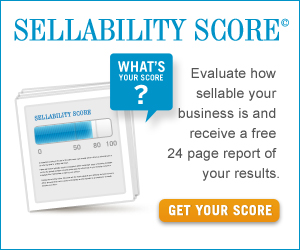Republished with permission from Built to Sell Inc.
The most powerful metrics in any business are ratios that express your performance on metric A as it relates to metric B. For example, knowing what your revenue was last year is interesting; but knowing what your revenue per employee was will give you a sense of how efficient your business is at leveraging your investment in people.
If you’re a retailer, knowing what your sales were last year is far less useful than knowing what your sales per square foot were, as this measures your effectiveness at leveraging your investment in retail space.
One of the most important ratios to keep an eye on is your ratio of CUF:CAC. CUF stands for Cash Up Front, and it is the amount of money you get from a customer when they decide to buy. CAC stands for Customer Acquisition Cost, and it is the amount of money you need to invest in sales and marketing to win a new customer.
Improving your CUF:CAC ratio can ensure that you have the cash to grow your business without having to rely heavily on outside sources of capital.
HubSpot
To understand the CUF:CAC ratio, let’s first look at HubSpot.com. HubSpot is a software business that provides a platform for businesses to manage all of their marketing. HubSpot allows businesses to build a website, set up a blog, manage their social media accounts, create email marketing campaigns, and analyze it all through a single dashboard. It’s an all-in-one marketing platform for businesses, and HubSpot’s typical customer is a small to mid-sized company that needs to present a professional online image but doesn’t have the necessary internal resources or the budget to hire a team of designers.
According to a recent article in Forbes, HubSpot invested an average of $6,793 to win a new customer in Q2 2012. Their average customer paid $577 per month for access to the software, so if HubSpot had charged its customer just the monthly subscription fee, their CUF:CAC ratio would have been an abysmal .084:1.
But obviously HubSpot is in the subscription business, so they get $577 per month, and their average customer stays with HubSpot for more than three years, so they clearly recover the cost of acquisition over the lifetime of the customer. However, if they hadn’t had a strategy to improve their initial CUF:CAC, they would have required a boatload of money from outside investors.
To improve their CUF:CAC, HubSpot sells an “Inbound Marketing Success Training” package and charges new customers $2,000 to recover some of the costs of getting them set up. By charging $2000 upfront for the training package, their CUF:CAC ratio goes up to a much more respectable .37:1.
Forrester Research
To understand a company with an excellent CUF:CAC ratio, take a look at Cambridge, Massachusetts-based Forrester Research. Forrester’s primary business is selling syndicated market research on a subscription basis to billion-dollar companies. Founded in 1983, today Forrester generates roughly $300 million dollars in revenue from 2,451 customers, including 38 percent of the Fortune 1000.
Their core product is called “RoleView,” and for around $30,000 per year, Chief Information Officers (CIOs) and Chief Marketing Officers (CMOs) can get research insights delivered to them based on their functional role within their company. Each RoleView subscription typically includes access to research, membership in a Forrester leadership board where peers discuss issues they have in common, phone and email access to the analysts who perform the research, unlimited participation in Forrester Webinars, and the right to attend one live event.
Unlike HubSpot that primarily charges by the month, Forrester RoleView subscriptions are mostly charged annually, upfront. Subscribers get an entire year’s worth of their customer’s money in advance, giving them a positive CUF:CAC ratio. George F. Colony, CEO and Chairman of Forrester, revealed the benefit of charging upfront for subscriptions in his letter to shareholders in early 2013. He concluded: “Forrester’s business model yields healthy levels of free cash flow. We typically carry between 50 and 100 million dollars in cash.”
Your CUF:CAC ratio is all about improving the cash flow in your business, which is one of the eight key drivers of Sellability.
Why not find out now if your business is sellable?
This free online tool is the only no-risk step you can take to determine if your business is ready to get full value. Fast-track your analysis by taking advantage of this free, no-obligation free online tool.
This Sellability Score you instantly receive is a critical component to any business owner’s complete financial plan and is something that, until now, we have only made available to existing clients.
However, we recognized that there is value in knowing in advance of working with a financial planner whether or not your largest asset is ready to be exchanged for your retirement nest egg. Our view is that you are better to learn more about your businesses sellability today and find out how your business scores on the eight key attributes so that you can ensure you obtain full value.
If your business part of your retirement plan, finding out your sellability score will be the best 10 min. you could ever spend working “on” your business.
 For more free information on Creating A Business Owner’s Dream Financial Plan, you can listen to a free, eight part series we did exclusively for business owners. The show is also available to subscribe to for free via iTunes.
For more free information on Creating A Business Owner’s Dream Financial Plan, you can listen to a free, eight part series we did exclusively for business owners. The show is also available to subscribe to for free via iTunes.





 In today’s episode, I chat with Charles Wilton, Portfolio Manager with the Private Investment Management Group at Raymond James. We talk about the recent changes in his portfolio and why he decided to buy Everest Reinsurance.
In today’s episode, I chat with Charles Wilton, Portfolio Manager with the Private Investment Management Group at Raymond James. We talk about the recent changes in his portfolio and why he decided to buy Everest Reinsurance.








